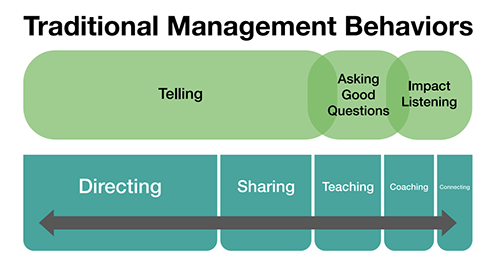 How do we address the personal, human side of business and leadership with our inherent management expectations of delivering results?
How do we address the personal, human side of business and leadership with our inherent management expectations of delivering results?
As managers and leaders, our jobs are multifaceted. We play different functions in our interactions with team members. These functions exist on a continuum, ranging from directing to connecting.
We direct our teams — providing feedback, vision and clear priorities. We share our perspective, our experiences and our reasonings. We teach new skills and new ways of thinking. We coach team members as they practice new skills so they can move from basic to expert. We connect with our team members, generating trust and commitment.
Traditionally, our application of these functions has been lopsided, with most of our interactions on the directing side of the continuum and few on the connecting side. While command-and-control management can deliver results in the short term, it doesn’t last.

It leaves us managing compliance, day after day. We’re stuck checking and following up and monitoring team member work. But this trap puts a self-imposed constraint on the amount of engagement and commitment you receive from the team.
To transition from managing compliance to inspiring engaged commitment:
Choose a Different Balance: Tell Less. Ask More. Listen the Most.
Improve Effectiveness in Each Function: Bring greater connection-generating behaviors into all five functions
Set Intention: Pausing to set your intention creates purpose that inherently improves the value and outcome of your interaction.
To build connection that inspires engaged commitment, we must treat our team members like people. People that have inherent gifts. People that matter. People that we genuinely care about.
Learn more on transitioning from command-and-control management.